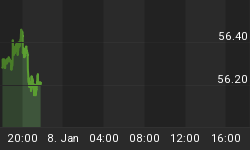Rotational combines component rotation and asset class rotation to hold a small basket of ETFs or ETNs, selecting the handful with the most momentum from a representative sampling of classes and components. Throughout this article, when I refer to momentum, I am referring to an exponentially smoothed measure based solely on price movement.
Information is as of the close on March 7, 2008.
Model Allocation
Based on beginning with a $100,000 portfolio at inception, these are the current weights and holdings. The initial target was a buy of 10% weights per position. See my previous post on this system. Sort is alpha order by ticker and weights are rounded to the tenth of a percent.
Agriculturals (DBA) - 11.0%
Malaysia (EWM) - 8.4%
Brazil (EWZ) - 9.6%
Yen Currency (FXY) - 9.5%
Gold Miners (GDX) - 10.1%
Gold (GLD) - 11.8%
India (INP) - 7.5%
Silver (SLV) - 10.6%
Treasuries 20+ Yrs (TLT) - 9.9%
Oil (USO) - 11.2%
Cash - 0.3%
Returns
Based on beginning with a $100,000 portfolio at inception.
Equity: $99,943.08
Gain, Past 4 Weeks: 3.76%
Gain, Year to Date: -1.65%
Gain, Since Inception: -0.06%
The following ETFs in the Rotational portfolio paid dividends or distributions in the past four weeks: TLT. Payments are included in the stated returns.
Total dividends = $37.22 on the tracking portfolio. This amount is included in the returns shown above, and will remain in cash until needed for a new purchase. Note, commissions are expensed at $10.00 per trade when accounting for returns.
Changes To Model Allocation
Rotational screens for momentum inside a list of ETFs and ETNs by asset class category. Provided that momentum is positive, one issue from each asset class will be held, with the remainder of positions allocated to the issues with the most momentum, regardless of asset class.
If this system were to be initiated today, the target allocation would be a buy for 10% weight holdings of the ten issues highlighted in gold or green in the table below. Items highlighted in gray are "sells" from the existing model portfolio. Note that five of the six asset classes have at least one bullish member, and the other five allocations this period go to other ETFs that are leaders in my smoothed momentum measurement.
If the table is truncated in your browser, click on it to view it in its own pane. Depending on your browser, you may have to click again to view it in full size.

Tracking
Shares of EWM, FXY, INP, and TLT will be sold, market at open on Monday. The proceeds, plus all available cash, comprise 35.7% of portfolio weight, and will be split equally into allocations for new buys IEF, FXF, SLX, and XME, based on closing prices on March 7. I will round down any fractions in the share calculation.
Commentary
Below, I present the change in rotational momentum from the last evaluation to the current one. It can be quite instructive.

Here is a table that shows the average momentum for the different issues in each asset class, at different evaluation dates from the inception of the program.

Looking back at the changes in momentum for various asset classes and the issues inside them, it appears that bonds (BND) have topped in momentum, and shorter-duration bonds have gained relative to longer-duration bonds; commodities (CMD) are accelerating; foreign currencies (CUR) slowed and then re-accelerated, with carry trades having suffered, but possibly resuming over the last month; foreign-country markets (CNT) topped last year and have fallen into negative momentum, with the U.S. measurement (through the SPY) having less loss of momentum than the average foreign country index; the individual domestic U.S. industries (IND) may be bottoming here; and the property REITs (PRP) appear to have bottomed at the beginning of 2008.
Whether or not these trends will continue ... is another question entirely.
I believe these trends are consistent with a theme, wherein the U.S. is leading the rest of the world both into an "economic slowdown," and also into an "economic recovery," via an "inflationary credit loosening cycle" that will cause the U.S. markets to gain relative to foreign and emerging markets, and spark a "recovery" in U.S. real estate.
Whether or not this theme is accurate, or will continue to play out ... is another question entirely.
My personal trades have been mirroring the Rotational plan since its inception; I haven't decided yet if I want to deviate from that, with this month's change.
















